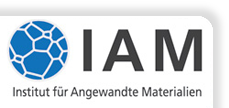Micro and element analysis
Chemical Analysis at IAM-AWP uses a wide range of modern analytical instruments and methods to solve analytical questions in materials research within the Helmholtz-Programs Nano- and Microtechnology, Nuclear Fusion and Nuclear Safety Research as well as Efficient Energy Conversion and Use.
Established analytical methods are validated and developed for the continously newly developed materials. The reliability of the analyses is verified by the organisation and participation in ring analyses. Our expertise is also available for external clients and partners. The Chemical Analysis group is part of the Karlsruhe Nano Micro Facility (KNMF), the EUMINAfab and QNano, national and european infrastructures for the production, characterization and safety research of micro and nano materials.
Analytical Methods
- Auger electron spectrometry
- ICP mass spectrometry
- LA-ICP Mass spectrometry
- ICP emission spectrometry
- X-ray fluorescence spectrometry
- C-S-Analysis
- O-N-Analysis
Auger electron spectrometry (AES)
|
Lateral high resolution Auger electron spectrometer |
Elements: Li to U Detection limit: > 0.5 % - 5 % (depending on element); Measurements and capabilities: Multipoint and area analysis, linescans, element maps ranging from ∅ > 24 nm to µm and depth analysis from 1 Materials: electrically conducting and semiconducting solids and layers Applications:
|
ICP Mass spectrometry (ICP-MS)
|
|
Quadrupol mass spectrometer (Agilent 7500ce) with inductively coupled plasma ion source and reaction gas cell (He, H2) |
Elements: Li to U except noble gases, C, N, O and F
Detection limit: 0.0001 to 10 µg/L (ppb), depending on element
Samples: aqueous solutions and dissolved solids
Special sample preparation: Microwave digestion system for solids, "subboiled" acids
Applications:
Ultratrace- und isotopic analysis in
- water, waste water, eluates, aerosols, slag, ash, soil
- metals and alloys such as tungsten, molybdenum, steel, special alloys etc
- oxides, nitrides, carbides such as SiO2-, TiO2 nanopowder, C nanotubes
Laser ablation coupled to ICP mass spectrometer (LA-ICP-MS)
|
Laser Ablation System
|
Elements: Li to U except noble gases, C, N, O and F Detection limit: < µg/g (depending on element) Samples: anorganic and organic solids Measurement capabilities: point analysis, linescans, with diameter and linewidth of 5 - 150 µm under normal pressure Applications:
|
Optical ICP emission spectrometry (ICP-OES)
|
Optical emission spectrometer |
Elements: Li to U except noble gases, halogenes, C, N and O Detection limit: 0.05 to10 µg/L (ppb), depending on element Samles: Solutions and dissolved solids Special sample preparation: Microwave digestion system for solids with "sub boiled" acids; bead machine for solids Anwendungen: Trace analysis up to the determination of main components in
|
X-ray fluorescence spectrometry (RFA)
|
X-ray fluorescence spectrometer |
Elements: B to U in solids, Na to U in solids and liquids Detection limit: 0.0001 to 0.1 % depending on element and matrix
Special sample preparation: automatic bead machine with Perl’X 3 Applications: Determination of main and minor components
|
|
C/S-analyzer ((CS600, LECO), |
Elements: C, S, differentiation of organically and inorganically bound C Detection limit for C: 5 to 60000 µg Detection limit for S: 2 to 4000 µg Materials: all solids Applications:
|
|
Trägergasheißextraktion (TC 600, LECO): |
Elements: O, N Detection limit for O: 0.1 to 50000 µg Detection limit for N: 0.1 to 30000 µg Materials: all solids, especially metals Applications:
|


